September 9th, 2008
A group of them were building Excel spreadsheets into which they’d dump all the information they’d gathered about how each boss behaved: What potions affected it, what attacks it would use, with what damage, and when. Then they’d develop a mathematical model to explain how the boss worked—and to predict how to beat it.
From How Videogames Blind Us With Science, an article in Wired by Clive Thompson. This provides me with an example of the scientific method in an everyday context. The conversations between the players were available for later reading…
...the conversations often had the precise flow of a scientific salon, or even a journal series: Someone would pose a question—like what sort of potions a high-class priest ought to carry around, or how to defeat a particular monster—and another would post a reply, offering data and facts gathered from their own observations. Others would jump into the fray, disputing the theory, refining it, offering other facts. Eventually, once everyone was convinced the theory was supported by the data, the discussion would peter out.
So what I need now are examples of that discourse in laboratories that ‘do’ actual science.
Posted in Learning, Scientific method | Comments Off
September 4th, 2008

Using illustrations to convey concepts can save time and can support students who have a visual orientation. Drawing a visual representation of a set of ideas or a process forces you to think in a different way compared with linear text. A project run by several Universities in Europe has resulted in the visual-literacy.org Web site. I’ve linked to the wonderful Periodic Table of Visualization Methods before, now more content has been added, including a couple of demonstration courses on Visual Literacy.
The demonstration courses are available with guest access in a local Moodle installation (another example of a project being run on the Moodle platform when the partners use different platforms for normal business). One course is aimed at business people and the other at engineers.
Posted in ILT, Learning | Comments Off
August 27th, 2008
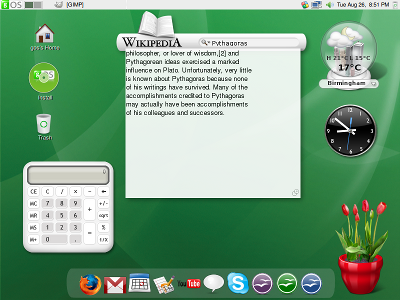
gOS is a version of Linux that is intended to be easy to use and designed around what most computer users want to do (Web, photos, music, e-mail, documents). The distribution is based on Ubuntu, in turn based on Debian, but the gOS people have made an honest attempt to make the desktop easy to use and nice looking (if you are into snot green that is). Like Ubuntu, gOS can be downloaded, burned to an .ISO format CR-ROM, and then run as a ‘live’ CD by booting your computer. The hard drive of your computer is not changed at all. You need at least 512Mb of RAM to run the live CD, and the more RAM the better it runs. gOS is aimed at small laptops like the Asus – many PC manufacturers have realised that there is a market for simple cheap Web clients.
Above is the snot green desktop, and you may notice a slight resemblance to a well known commercial operating system. On my Asus Pundit with an AMD processor, the live disc runs in 800 by 600 screen resolution, probably because it can’t find drivers for the nvidia integrated graphics on this machine.
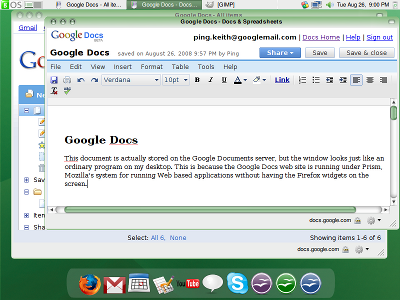
The dock panel at the bottom of the screen has animated icons that represent programs and shortcuts to Google Mail and Google Docs. The screenshot above shows me editing a Google document, and you will see how the windows look like normal windows, not like the Firefox Web browser. Mozilla Prism allows Web based applications to use the Gecko rendering engine that is part of Firefox to run applications in windows that appear with the ‘usual’ window look on that OS. I think this is a good idea, and lets face it, if students were using Google Docs more, on balance they would loose less work! I’m having a real push on ‘safe data’ this year as we had so many damaged or lost USB stick issues last year.
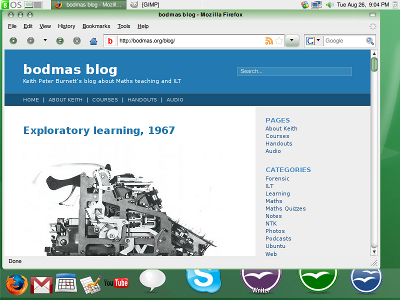
I don’t like the current implementation of the dock panel at the bottom of the screen. As you can see, when you do the ‘animation’ thing by running your mouse over the icons, they expand under the window with focus. The panel should be ‘always on top’ but I haven’t found any settings that allow this yet. Worse, when you maximise an application window, it covers the panel at the bottom of the screen completely, and you can’t access the panel except by resizing the application window. Other desktop managers like Xfce and Gnome manage to prevent application windows from covering the panels – they ‘protect’ a region of the screen for the panel when you maximise the window. These issues would be annoying over time, and detract from the simple and bold desktop.
This is a beta release and I hope that there will be fixes. The basic idea of a desktop integrated to Web services and a few local applications (OpenOffice, Thunderbird for mail) is very interesting.
Posted in ILT, Ubuntu | Tags: gOS, interface, web2 | Comments Off
August 25th, 2008
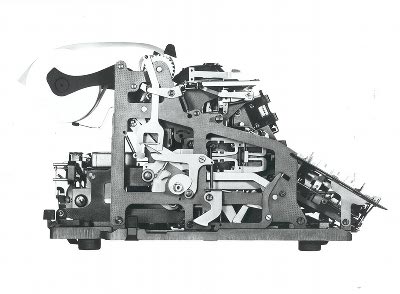
A school in Dagenham was loaned seventeen Summa 20 and six Divisumma 24 [calculators] in an experiment to teach maths. The Olivetti machines replaced log tables and slide rules for two groups of 11 to 15 year olds. The first group were given 2.5 hours tuition to learn multiplication. Whereas the second group were left to discover for themselves how to use the machines. The second group learned the quickest. British Olivetti Ltd newsletter, 1967
Exploratory cooperative learning with corporate sponsorship in 1967!
Posted in Learning | Comments Off
August 18th, 2008
“Many of the students we spoke to are making some use of their own tools to socialise and network in personal and public spaces, and in doing so are actually supporting their learning in that they use these tools to communicate and share information and resources between themselves and their peers, even though they did not necessarily view this themselves as ‘learning’ per se. However there was little evidence that institutions were providing this functionality formally. On an informal basis students are generally being encouraged to share their contact details, but from the staff viewpoint this was seen more as a way of the students passing organisational information rather than for learning purposes.”
From Learning from digital natives: bridging formal and
informal learning via the twofourlearning blog. Students will always self organise, my mature Maths students were helping each other stay focussed on revision just before the GCSE exams using MSN and mobile phone text messages. How do we make the best use of this self-organisation?
Posted in ILT | Tags: self-organisation, web2 | Comments Off
August 18th, 2008
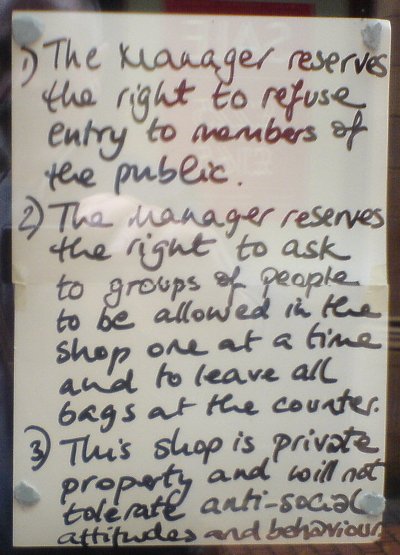
It is that time of year again, teaching will be under way in a month or less. This photo makes me think about negotiating the ground rules with new classes of students (I’m a bit more liberal than the ‘manager’). I’ll need to add in some rules about using Moodle/e-mail as well, if only to reassure students that it is OK to e-mail and post questions on the course forums.
Posted in Learning, Photos | Tags: behaviour, classroom | Comments Off
August 9th, 2008
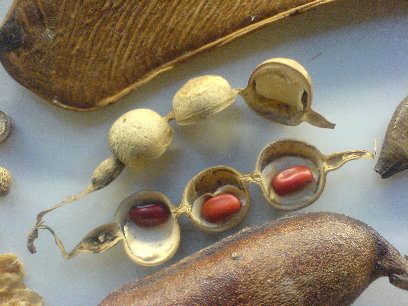
The Pitt Rivers Museum is closed until ‘Spring 2009’ (read sometime after Easter) but then my favourite museum will be restored to its Victorian splendour with the 1960s exhibition gallery removed. In the mean time, The Oxford University Museum of Natural History continues to amaze children and provide a nice place to shelter from the rain for the older generation.

Back to work soon, so more Maths worksheets in the offing.
Posted in Notes | Tags: caption, exhibition, museum | Comments Off







